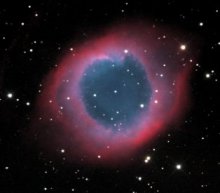
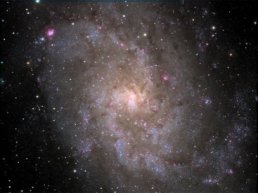











Recent Images -- Last Updated 6/23/2021
The images below
will not show up on the other pages until they are replaced on this one.
You won't see any repeats when you go to one of the links on the left.
Basic information about the telescopes and cameras is at the bottom of
this page.
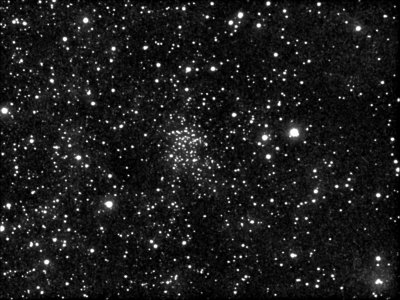 Tombaugh 4
Tombaugh 410-inch Newtonian, ST2000XM, 28/0/0/0
Clyde Tombaugh, the discoverer of Pluto, identified five open clusters during his search of plates from the Lowell astrograph. Later, one of them was found to be a duplicate discovery of IC 166. The first two of his list were imaged previously, along with IC 166, and can be found on the Open Clusters page. This is a monochrome image as I never got around to doing the colors.
Tombaugh 4 is listed as 5.3' in diameter and contains 40 stars.
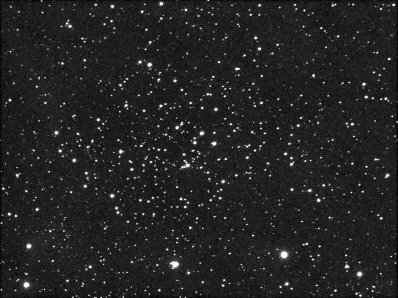 Tombaugh 5
Tombaugh 5
10-inch Newtonian, ST2000XM, 60/0/0/0
See Tombaugh 4 above for some background on the Tombaugh clusters.
While Tombaugh 5 includes more stars than 4, it is much more sparse, with 60 stars spread out over a 17.0' diameter.
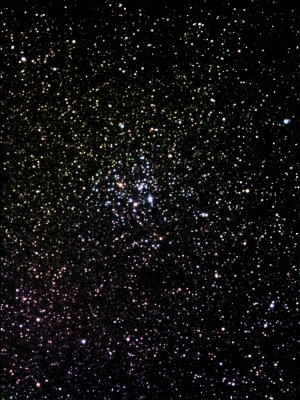 Messier 26 (NGC 6694)
Messier 26 (NGC 6694)ED80, ST2000XM, 16/16/16/16
This was one of my first images with the Explore Scientific ED80. It was made from my yard in The Woodlands, TX. M26 is fairly sparse, with only 30 stars in a 14' diameter. You can count far more than 30 stars within its boundaries but most are either foreground or background stars. While attractive, it is an unspectacular cluster.
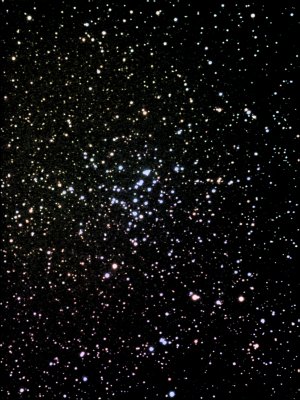 NGC 6866
NGC 6866
ED80, ST2000XM, 40/16/16/16
NGC 6866 contains 60 stars in a 10.0' diameter. The magnitude, as listed by Megastar, is 7.6. It was discovered by Caroline Herschel.
Like the M26 image above, it was acquired in my light polluted yard.

NGC 896
Celestron CG 9 1/4, ST2000XM, 90 H-alpha
I acquired R, G, and B frames to go with this H-alpha frame but was very dissatisfied with the result. For me, the H-alpha alone is much more satisfying.
This is just a small part of a huge complex of nebulosity and star clusters. It is sometimes called the W4 complex, the IC1805 region, or the Heart Nebula complex. Tomball 4, above, is within this larger complex. As I understand the designation, NGC 896 is the large bright blob to the lower right of the image and the fainter component to its left is IC1795. For an extensive discussion of the whole region, see Annals of the Deep Sky, Vol. 4, by Kanipe and Webb.
Acquired from my yard.
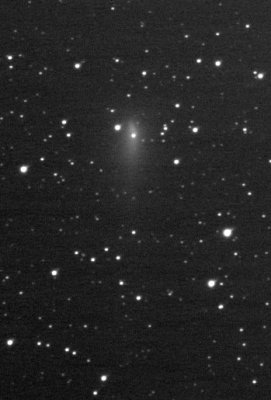 Comet C/2019 Y4 (Atlas)
Comet C/2019 Y4 (Atlas)ED80, ST2000XM, 30/0/0/0
I don't normally image solar system objects as my equipment is really intended for deep sky work. However, the comet was well-placed for my yard on April 14, 2020 so I decided to grab it. I guided and stacked on the comet head. I was surprised that the stars showed so little elongation; the brighter stars just show a spike pointing to the upper right in the image.
Images take by amateur astronomer Jose de Queiroz on April 11 showed the head had split into three pieces. My image does not show that, either because two of the pieces had disintegrated or because my resolution was not adequate to show them. The fairly dense coma in front of the head makes me bet on disintegration.
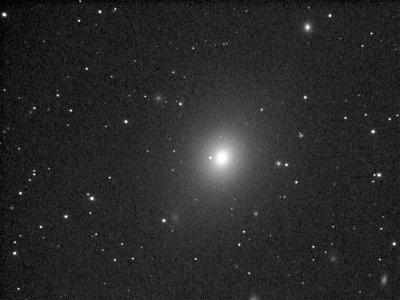 M49 (NGC 4472)
M49 (NGC 4472)10-inch Newtonian, ST2000XM, 12/0/0/0
This is a very short exposure, only 12 minutes, but shows many objects in this very densely populated region of Virgo. If you have Megastar or a similar sky map program, you'll probably be able to identify all the galaxies down to magnitude 25 and, on the full size image, find many more.
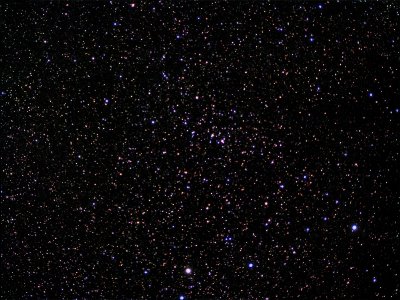 NGC 7082
NGC 7082Astrotech AT66, ST2000XM, 60/20/20/20
NGC 7082 is a less than impressive open cluster. The catalog data says it contains 182 stars in a 24' diameter but it does not look that rich to me. It is close to M39 but is much older. It does not appear to have been studied much.
Again, from my yard.
 M106 (NGC 4258)
M106 (NGC 4258)Celestron CG 9 1/4, ST2000XM, 84/32/32/32
Messier 106 is a big (18.6' x 7.2') SAB(s)bc galaxy located in Canes Venatici. It was a "late" addition to Messier's catalog, having been added in 1947 based on research by Helen Hogg. It was discovered by Pierre Mechain in 1781. But many of Mechain's discoveries were included in the catalog and it appears certain that Messier was aware of it.
106 has an active nucleus with a supermassive black hole, a short bar, complex arms, and a very large faint halo. Above and to the right of 106 is NGC 4248, a peculiar irregular.
This image was acquired at the 2017 Texas Star Party. I had expected a better result but was dealing with dewing and poor transparency on the night it was made.
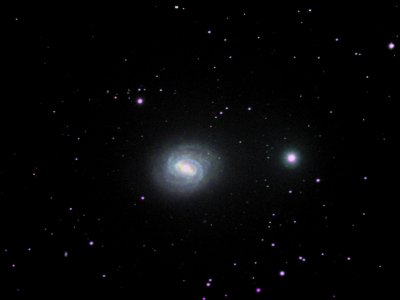 M58 (NGC 4579)
M58 (NGC 4579)Celestron CG 9 1/4, ST2000XM, 120/32/32/32
M58 is another of my images from the 2017 TSP. Conditions were better than they were for M106, and the results were better. M58 has a short bar, easily seen, and a central black hole. It is 5.9' x 4.7', and is classified as SAB(rs)b. The distance to M58 is about 62 million light years and it is the most distant Messier object. It is surrounded by a large number of very tiny galaxies, many of which are undoubtedly satellites
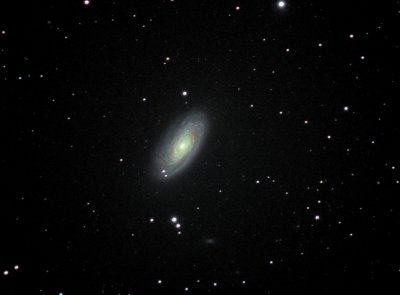 M88 (NGC4501)
M88 (NGC4501)Celestron CG 9 1/4, ST2000XM, 80/24/24/24
M88 is inclined 30 degrees to our line of sight, giving it an elliptical appearance similar to the way we see M31, the Andromeda Galaxy. The arms are very crisp and fairly tightly wound; they can be traced all the way to the core. M88 is 7.0' x 3.7', and classified as SA(rs)b
While there are numerous tiny galaxies in the field, the only one of any size is VCC 1400, below and slightly right of M88.
Also a 2017 TSP image.
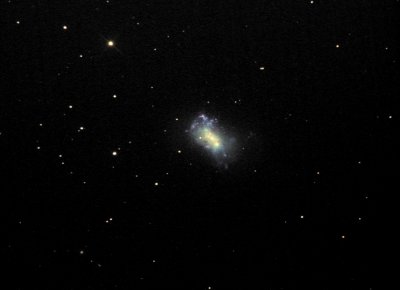 NGC 4449
NGC 4449 Celestron CG 9 1/4, ST2000XM, 48
10-inch Newtonian, ST2000XM, 80/28/28/28
NGC 4449 is a fascinating object. It is a very boxy irregular (IBm), similar to the Large Magellanic Cloud except that it is one of the most active starburst galaxies in our part of the universe. For a thorough discussion of all its interesting aspects, see Kanipe and Webb, Annals of the Deep Sky, vol. 3. I could not begin to fit all of it on this page.
My original image was done at my observatory but sky conditions were not great during acquisition of the luminance, so I collected more at the 2017 TSP. The 48 minute image there was much better than the earlier 80 minutes, so I merged the images 75/25, favoring the TSP shot.
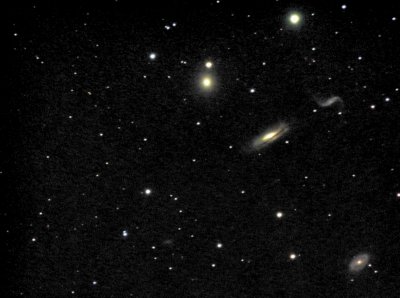 NGC 3190 Group (Hickson 44, Arp 316)
NGC 3190 Group (Hickson 44, Arp 316)Celestron CG 9 1/4, ST2000XM, 140/48/48/48
I don't usually attempt galaxies, particularly faint ones, from my home. But I got started on this one just as a test and decided to finish it. Even with the long exposure, the background is quite noisy. A 45/15/15/15 image at my observatory would probably have been just as good. The field was offset to find a guide star.
This is an interesting group. The four brightest galaxies make up Hickson 44, while the three northernmost are identified as Arp 316. NGC 3190, the brightest, is an edge-on spiral. Its classification is SA(s)a pec sp. The integral sign galaxy to the right is NGC 3187, while the E2 galaxy to the left is NGC 3193. The ring galaxy in the lower right corner is NGC 3185. It is included in the Hickson group but not in the Arp. The classification is (R)SB(r)a. The only other galaxy of any size (but less than an arc minute) is in the lower middle of the field. NED lists the name as LSBC D500-05, but it is listed in a number of other catalogs.
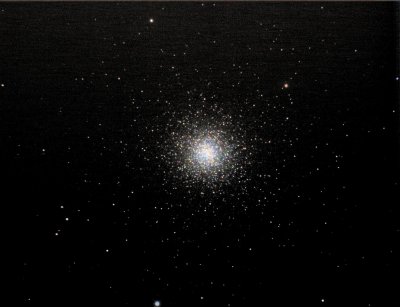 M3 (NGC 5272)
M3 (NGC 5272)10-inch Newtonian, ST2000XM, 20/7/7/5
I would normally use a longer total exposure for a globular cluster like this but I was doing a test for a talk I'll be giving to the local camera club. This image uses 30-second individual exposures with no guiding. I had to toss a few but the ones I kept produced a reasonably good result. I wanted to show what a beginner might achieve without the complexity of guiding.
M3 is notable for having a large number of variable stars, especially RR Lyrae variables. Also, Sandage first identified "blue stragglers' in this cluster in 1953. These are massive stars that should have left the main sequence long ago but which, for some reason, have not or, more likely, have left and then returned.
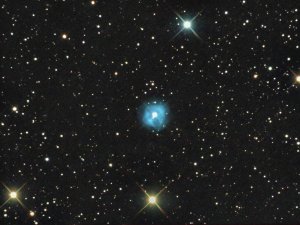 NGC 1514
NGC 151410-inch Newtonian, ST2000XM, 76/28/20/28
NGC 1514 is a beautiful planetary nebula located in Taurus. It was discovered by William Herschel in 1790. It has a bright central star which produces diffraction spikes in my Newtonian telescope. These a no more "real" than the diffraction spikes on the other bright stars in the field. The denser central part of the nebula contains a number of overlapping bubbles which give it a lumpy appearance. There is a fainter outer envelope. Al Kelly reprocessed my original image to eliminate gradients and reduce the noise. Thanks, Al.
The central part of 1514 is just a little larger than the equivalent part of M57, the Ring Nebula. The Ring also has an outer envelope which is even larger but much fainter.
 NGC 2327, IC 2177, and More
NGC 2327, IC 2177, and More10-inch Newtonian, ST2000XM, 60/24/24/24
NGC 2327 is the small bright nebula just above center. IC 2177 is the nebulosity occupying the lower left two-thirds of the field. This is a huge object, 150' x 60', with only a small portion visible here. It includes numerous areas of dark nebulosity, a few of which can be seen in this image. GN 07.01.4 sweeps to the right, away from the bright star in the lower right of the field. It consists of a small bright area overlapping the star and a longer, but fainter, streamer looking very much like a comet. It is also known as Magakian 241 and is classified as a cometary nebula, but is not a typical cometary in either appearance or location. Finally, the cluster of bright stars just left and below GN 07.01.4 is the open cluster VdBergh 92. It contains 12 stars within a 3' diameter.
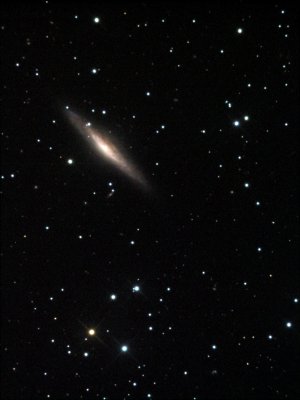 NGC 2683
NGC 268310-inch Newtonian, ST2000XM, 48/20/20/20
NGC 2683 is believed to be a barred spiral, even though no bar can be seen in even the best available images. It is nicknamed the UFO Galaxy because its appearance matches fairly closely a number of descriptions of various supposed UFOs. The yellow to brownish color, especially near the core, is a result of dust in the galaxy halo. There a many small background galaxies in the field.